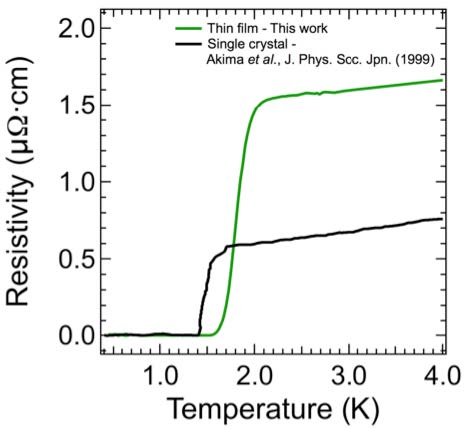A key step toward ground-state quantum computing
Quantum computers promise exponentially enhanced efficiency in performing calculations of great real-world importance. Unfortunately, in virtually all implementations of a quantum computer, one of the states is an excited state that must, of necessity, decay spontaneously into its ground state. This ‘decoherence’ quickly destroys the quantum calculation. A fascinating alternative form of quantum computing has been proposed: braiding pairs of ground-state non-abelian anyons in two dimensions. Importantly, an anyon is not an excited state and so does not suffer decoherence, preserving quantum information ad infinitum. In principle one of the simplest ways to create and use pairs of such anyons occurs in odd-parity topological superconductors (OPTS). Sr2RuO4 is the leading candidate for an OPTS and phase-sensitive measurements on Sr2RuO4-based heterostructures would be an excellent way to test whether Sr2RuO4 is suitable for this application.
 |
| Figure 1: Resistivity versus temperature graph comparing Thin Film of this work to published Single Crystal Data (Reference Akima et al. Journal of Physical Society, Japan (1999) |
Thin film techniques are appropriate for making such heterostructures, provided superconducting Sr2RuO4 films can be grown and incorporated into them. The challenge has been that Sr2RuO4 is the most disorder- sensitive superconductor known. PARADIM’s in-house research team recently became the only group in the United States to have successfully synthesized superconducting thin films of Sr2RuO4. The temperature at which PARADIM’s Sr2RuO4 films superconduct is not only nearly twice as high as the best prior superconducting Sr2RuO4 films, but as can be seen from the figure even exceeds that of the best Sr2RuO4 single crystals.
Reference: H.P. Nair et al.APL Mater. 6 (2018) 101108
Technical details:
Ruthenates with perovskite and perovskite-related structures host a remarkably diverse class of exotic quantum phases ranging from spin-triplet superconductivity, ferromagnetism, metamagnetism, spin-density waves, antiferromagnetism, and quantum criticality—all with the same basic building block of corner-sharing RuO6 octahedra containing Ru4+ ions. Among these quantum materials, Sr2RuO4 is particularly interesting because it might enable ground-state quantum computing. While Sr2RuO4 is the leading candidate for an odd-parity topological superconductor that supports Majorana zero modes, conclusive evidence is still lacking. Phase-sensitive measurements on Sr2RuO4-based heterostructures would be an excellent way to test the proposed px+ipy pairing symmetry of the superconducting order parameter of Sr2RuO4. Thin film techniques are an excellent way to make such heterostructures, provided superconducting Sr2RuO4 films can be grown and incorporated into them. The challenge, however, is that Sr2RuO4 is the most disorder-sensitive superconductor known. This extreme sensitivity is why superconducting Sr2RuO4 thin films have evaded synthesis for so many years.
PARADIM’s in-house team recently succeeded in the growth of superconducting Sr2RuO4 thin films by MBE on (110) NdGaO3 substrates with superconducting transition temperatures (Tc) of up to 1.8 K. This Tc is not only nearly twice as high as the best prior superconducting Sr2RuO4 films, but as can be seen from the figure this Tc even exceeds that of the best Sr2RuO4 single crystals. Our in-house team is the only group in the United States to have successfully synthesized superconducting thin films of Sr2RuO4. Quantum oscillations measurements on our superconducting films show that our superconducting Sr2RuO4 films have a mean-free path of 144 nm (B.J. Ramshaw, unpublished). This rivals that of the best superconducting Sr2RuO4 single crystals (mean-free paths of 120–500 nm are reported for crystals with Tc 1.3–1.45 K) and shows that we are in an excellent position to create interface quantum materials with Sr2RuO4-based heterostructures and investigate their properties.
Full Reference: H. P. Nair, J. P. Ruf, N.J. Schreiber, L. Miao, M. L. Grandon*, D. J. Baek, B. H. Goodge, J. P. C. Ruff, L. F. Kourkoutis, K. M. Shen, and D. G. Schlom, “Demystifying the Growth of Superconducting Sr2RuO4 Thin Films,” APL Mater. 6, 101108 (2018).
Return to: In-house Research Highlights
Return to: In-house Research Highlights







